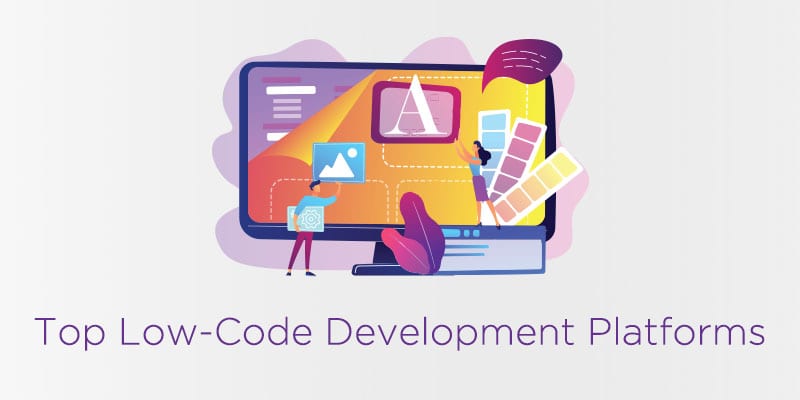Great Facts For Picking Low-Code Platform Info
Great Facts For Picking Low-Code Platform Info
Blog Article
The Benefits Of Low-Code Development For Non-Developers In Terms Of Accessibility
The following main factors make low-code development accessible to non-developers.
Drag-and Drop Builders: Low-code platforms come with drag-and-drop interfaces, which allow non-developers create apps without having to write any code. This makes the development process more accessible to those without technical background.
WYSIWYG editor: "What you see is what you will get" editors let users design interfaces, workflows, and other features in a way that is similar to the final product. They are easy to understand and to use.
Simplified Logic and Workflow Design:
Visual Workflow Modelling: Users are able to create business processes, application logic and flowcharts using diagrams as well as visual flowcharts. These techniques are more intuitive than traditional methods of coding.
Pre-built Logic Components: Low-code platforms include logic components already built (e.g. conditional loops and statements) that can be easily configured and without the need for complex programming.
Reusable Components and Templates:
Libraries of pre-built templates: Many low-code platforms offer a library of templates for common applications, enabling non-developers to start with a solid foundation to alter as required.
Reusable Modules and Widgets: Users can leverage reused widgets and modules to streamline the process of creating them and reducing the requirement for technical expertise.
Guided Development and Tutorials
Step-by step guides Platforms offer tutorials, tips on screen, and guided development paths to help non-developers build applications.
Interactive Tutorials. Interactive, hands on tutorials allow users to learn by doing.
Integration with tools already in use:
Seamless Integration: Low-code platform are designed to integrate seamlessly with the existing business tools, systems and software (e.g., ERP and CRM, ERP). This enables non-programmers with no background in programming to build applications that work with their existing workflows.
APIs/Connectors: The built-in APIs/connectors make it easy for non-developers connect their applications to other services.
Collaboration Features:
Team Collaboration: Features, such as real-time collaboration as well as shared workspaces, allow professionals and non-developers to collaborate efficiently.
Role-based Access Control: Non developers are able to be assigned certain roles, with appropriate access levels. This lets them participate in the development process without compromising security and functionality.
Automated Testing and Debugging
Built-in Testing Tools: Low-code platforms typically come with built-in testing and debugging tools to automate these procedures, making it much easier for non-developers to make sure the application is working properly.
Platform detects problems when they occur and offers fixes. This assists non-developers in problems.
Overall, the benefit of developing applications using low-code in terms of accessibility to non-developers is in its ability to democratize the development process. Low-code platforms are easy to use, visual tools, guided user experiences, and allow business users to actively participate in creating updates, maintaining and enhancing applications. Have a look at the best Low-code Platform for application development recommendations for website advice including app modernization, application modernization software, ms azure sql, cross platform app dev, ms azure sql, azure sql server, develop cross platform mobile app, driver jdbc, cross platform mobile dev, build a docker container and more.
Benefits Of Developing Applications Using Low-Code In Terms Of Governance And Security
Low-code application development offers several advantages when it comes to governance and security, which are crucial to ensure that applications are safe as well as secure and properly managed throughout their lifespan. These are the main advantages: Centralized Governance
Unified management console Low-code platforms usually provide a central administration console, where administrators are able to manage all the applications and ensure consistent governance within the company.
Role-Based Access Control RBAC: These platforms come with robust role-based controls that allow administrators to define access policies. Only authorized users are able to modify or access certain elements of a program.
Compliance and Regulatory Adherence
A lot of low-code platforms have built-in compliance features. These are designed to ensure that applications comply with the industry standard (e.g. GDPR, HIPAA). These platforms provide frameworks and tools to make sure that the applications are compliant with these requirements.
Audit Trails and Logging Comprehensive logging, audit trails and logs are usually integrated into businesses, allowing them to track changes and monitor access. They can also make sure that the organization is in compliance with both external and internal laws.
Increased Security Measures
Data Encryption Low-code platforms often have built-in encryption for data during transport and in rest, securing sensitive information.
Security Certifications: Many companies of low-code software have security certifications like ISO 27001 or SOC 2 to prove that they adhere to high standards. These certificates offer further assurance to users.
Automated security updates:
Regularly scheduled updates and patches Low-code platforms generally handle security updates and patches automatically, making sure applications are protected against the most recent threats, without the need for the intervention of developers.
Security Monitoring - Continuous security monitoring is typically part of the program. It provides real-time insight and alerts about possible security threats.
Data Governance
Data Access Policy: These platforms allow organisations define and enforce policies regarding data access, ensuring certain that only authorized users have access to data and that they are using it in a proper manner.
Data Masking and Anonymization Inbuilt tools for masking data and anonymization can help safeguard sensitive information, especially when working in testing and development environments.
Consistent application lifecycle management:
Development and deployment pipelines: Low-code platforms provide integrated development, including security checks. This guarantees security throughout the lifecycle of an application.
Version Control: The integrated version control allows for the management of modifications and makes sure that modification to the application can be tracked and reverted if necessary, maintaining the integrity of the application.
User Authentication, Authorization and Authorization
Single Sign-On (SSO). Support for advanced authentication and single sign-on simplifies and improves security.
Multi-Factor Authentication Most platforms can support multi-factor Authentication, which adds an extra layer to security when logging into applications.
Policy Enforcement and Compliance:
Policy Templates: Low code platforms typically have templates for governance and security which allow companies to swiftly adopt policies.
Compliance Monitoring Tools: These provide continuous monitoring and report on the status of compliance. This helps to identify potential issues and address them proactively.
Integrate with the existing security infrastructure:
Seamless Integration: Platforms using low-code are designed to seamlessly integrate with existing tools and infrastructure such as SIEM (Security Information and Event Management solutions) and firewalls.
API Security: Built-in API security features protect data, maintain application integrity and ensure safe integrations.
Training and best practices:
Guided Best Practices : Many platforms offer guidelines and best practices that can help non-developers to adhere to security standards.
Security Training Some low-code companies offer security resources and training to users to teach them how to create and maintain secure applications.
The security and governance capabilities of low-code applications ensure that they are built and managed in a safe and secure manner. These platforms provide the frameworks and tools necessary to protect sensitive information as well as enforce policies and ensure compliance with regulations while reducing management and oversight. Follow the top rated funny post about Enterprise application development with Low-code Platform for blog tips including microsoft azure sql, develop web app, rapid applications, stored sql procedures, no code platforms, stored sql procedures, rapid app development, cross platform mobile development, develop web application, lowcode no code and more.
Benefits Of Low-Code App Development In Terms Limitations And Customization
Low-code applications offer a balanced approach that provides significant advantages in terms of solving limitations and allowing modification. These are the main advantages: Handling Limitations
Overcoming Complexity Barriers:
Simplified development: Low code platforms simplify the process by offering templates and pre-built components. This facilitates faster application deployment, even for complicated ones.
Guided Workflows: Several platforms provide guided workflows and wizards to help developers navigate through the maze of processes, decreasing the chance of making mistakes and making sure that the process is consistent.
Scalability Solutions:
Scalability is built into: Low-code platforms typically include capabilities that permit scalable architecture. Applications can handle increased demands with little development.
Performance Monitoring: Tools that monitor and optimize performance help to make sure that applications run efficiently regardless of the fact that they are growing.
Security and Compliance
Integrated Security Features : Low code platforms come with security features built-in, such as encryption and role-based access controls. They also perform automated checks of compliance to deal with security concerns.
Platforms update frequently their security protocols, and make sure that they comply with regulations. This helps keep platforms safe from new threats.
Customization Options:
Extensibility:
Low-code platforms allow developers to enhance functionality beyond the standard offerings by adding custom code.
Custom Modules and Plugins: Developers have the option of creating custom modules or plugins to modify specific functionality to meet specific business requirements.
APIs & Integration:
API Support: The extensive API support permits seamless integration of other systems and services. This facilitates extensive customization and connectivity.
Third-Party services: Low-code platforms offer connectors that are built for popular third-party services. This makes it much easier to customize and integrate applications.
Flexible UI/UX Design
Customizable User Interfaces: Designers can alter and design user interfaces that are in line with the specifications for branding and usability, creating a tailored user's experience.
Responsive design: The ability to tailor applications for various screen sizes and devices is built-in.
The process of customizing Business Logic is easy:
Visual Workflow Builders Visual tools for designing and customizing workflows as well as business logic let developers create complex, tailored processes with no extensive coding.
Conditional Logic and scripting: Platforms permit the use of conditional logic, and custom scripting to manage specific business rules.
Data Management
Custom Data Models: Developers are able to develop custom data models that meet specific requirements of an application and ensure that data handling is customized to the business needs.
Advanced Data Processing: Integration advanced tools for data handling allow for the customisation of data analysis and utilization in the program.
Balance Customization and Limitations:
Frameworks and Standards
Low-code platforms encourage industry standards and best practices, which result in top-quality software that is scalable and safe.
Governance Frameworks. The built-in governance frameworks ensure that customizations will not compromise security, integrity, or compliance of the software.
Iterative Design and Feedback
Rapid Prototyping. Developers can develop and modify applications based on user feedback.
Low-code platforms are designed to allow for continuous improvement. This permits for modifications and improvements as requirements for business evolve.
User Empowerment
Low-code platforms empower citizen developers through letting non-developers with intuitive interfaces, to personalize applications, they expand the pool of developers who can improve and customize apps.
Training and Support Information: Many platforms offer extensive training and support materials to help users customize applications without compromising their stability or performance.
Low-code development is an effective framework that permits a lot of customisation while addressing any shortcomings. This balance allows businesses to build and maintain functional applications that are tailored to their specific needs, while maintaining high standards for quality, security and the ability to scale.